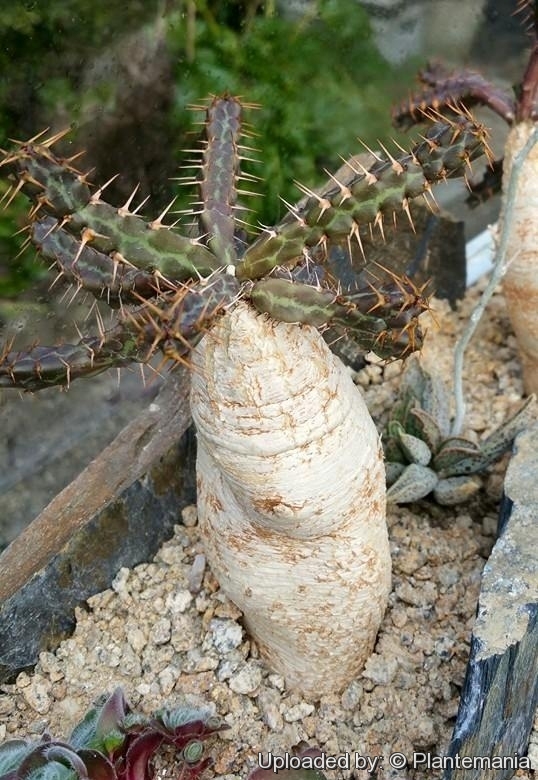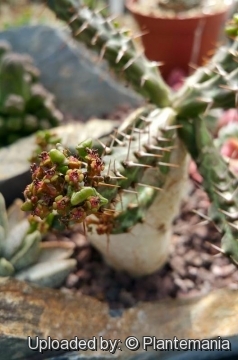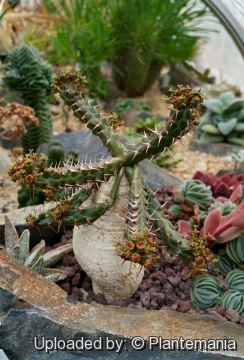
Euphorbia micracantha Photo by: © Plantemania
Origin and Habitat: Euphorbia micracanthaSN|33522]]SN|33522]] is rare in southeastern Cape, South Africa (Central region Somerset Div.; between the Zuurberg Range and Klein Bruintjes Hoogte.Coast region Bathurst Div.; between Blue Krantz and the sources of Kasuga River; Beaufort Div.; between Fish River and Fort Beaufort).
Altitude range: 520-1065 metres above sea level.
Synonyms:
See all synonyms of Euphorbia micracantha
back
Accepted name in llifle Database:Euphorbia micracantha Boiss.Cent. Euphorb. 25 1860.Synonymy: 4
back
Description: Euphorbia micracanthaSN|17359]]SN|33522]] a dwarf succulent perennial euphorbia with a long, fleshy rootstock (caudex) and a very short, thick primary shoot, at whose tip a wreath of 4 to 14 cm long leafless and spiny shoots emerge. The thorns are short, thin, and greatly flared. The cyathia are small, and the nectar glands are greenish yellow. E. micracantha is a bit like Euphorbia stellataSN|33522]]SN|17359]], but distinguished by its 4-angled branches and more slender spines.
Rootstock (caudex): The large, fleshy main root merges into the stem forming an cylindric-oblong rootstock often referred as a caudex, , 12-15 cm long, 6-7 cm thick , producing many branches at its apex.
Branches: More or less prostrate and radiating 4-14 cm long, 6-15 mm thick, radiately spreading, obtusely 4-angled, with slightly concave sides, straight or with a subtle stem torsion, glabrous, green without markings. Angles with shallow tubercles (podaria) to 8 mm apart
Stipular spines. Stipular in pairs 4-8 mm apart, diverging, 3-6 mm long, rather slender, on short rounded or slightly transverse spine-shields, grey.
Leaves: Rudimentary, scale-like, about 1 mm long, ovate, obtuse or subacute, concave, glabrous, soon deciduous.
Inflorescences (cymes): Solitary in the axils of the spine-shields, at the apical part of the branches, simple, subsessile 1-2 mm long, ultimately 3-flowered, with the lateral cyathis on very short peduncles, glabrous. Bracts scale-like, 1-1.5 mm long, ovate or oblong, obtuse, glabrous.
Flowers (cyathia): Male cyathia c 2 mm in diameter, female up to to 4 mm in diameter, cup-shaped, glabrous outside, apparently purple on some specimens and greenish-yellow on others, with 5 glands and 5 subquadrate minutely toothed lobes. Glands 1.1.5 mm in the male and about 2 mm in the female cyathia in their greater diameter, transverse, narrowly oblong, entire, rugulose, greenish-yellow and touching. Styles shortly united at the base, spreading, rather slender, shortly bifid at the apex.
Fruits: Deeply lobed as seen from above, with acute angles, glabrous, 3 long and 5 mm in diameter, exserted on a recurved pedicel to 6 mm.
Seeds: Subglobose, 1.5 mm in diameter, smooth.
Bibliography: Major references and further lectures
1) Urs Eggli “Illustrated Handbook of Succulent Plants: Dicotyledons” Volume 2.
2) N. E. Brown, J. Hutchinson and D. Prain “Flora Capensis”, Vol 5, 1925
3) Werner Rauh “The Wonderful World of Succulents: Cultivation and Description of Selected Succulent Plants Other Than Cacti” Smithsonian Institution Press, 1984
 Euphorbia micracantha Photo by: © Plantemania
Euphorbia micracantha Photo by: © Plantemania Euphorbia micracantha Photo by: © Plantemania
Euphorbia micracantha Photo by: © Plantemania Euphorbia micracantha Photo by: © Plantemania
Euphorbia micracantha Photo by: © PlantemaniaSend a photo of this plant.The gallery now contains thousands of pictures, however it is possible to do even more. We are, of course, seeking photos of species not yet shown in the gallery but not only that, we are also looking for better pictures than those already present.
Read More... Cultivation and Propagation: Euphorbia micracanthaSN|21556]]SN|33522]] is cultivated as an ornamental, and is a particular favourite of succulent plant enthusiasts. Cultivation of this plant is the same as that for the other tuberous varieties of Euphorbia, (e.g. Euphorbia stellataSN|25150]]SN|17359]], Euphorbia groenewaldiiSN|17359]]SN|25150]], Euphorbia deciduaSN|33522]]SN|21556]] etc.)
Growth rate: It is a slow growing species, but it it possible to increase the speed of growth to some extent by providing adequate amount of water, warmth, and fertilizer during the active growing season, but it’s susceptible to rotting if too wet and do not like a lot of water when they are on rest.
Soil and pots: It likes pots with generous drain holes, needs a very airy potting medium which mainly consists of non organic material such us clay, pumice, lava grit, and only a little peat or leaf-mould, seeing that the main trunk is planted with the majority of the roots below the caudex line. It's rare that it will use the upper third of its soil and often this area serves like a mulch or support for the stem.
Fertilization: Need a perfect fertilizer diet in summer. Use preferably a cacti and succulents fertilizer with high potassium content including all micro nutrients and trace elements or slow release fertilizer.
Exposure: This plant has an excellent heat tolerance, and need full sun to light shade exposures, it grows well even in full blasting sun, but can tolerate moderate shade, and a plant that has been growing in shade should be slowly hardened off before placing it in full sun as the plant will be severely scorched if moved too suddenly from shade into sun. The color of this plant is much more marked if grown in full sun.
Watering: Water regularly during the active growing season. No water should ever be allowed to stand around the roots. Keep almost completely dry in winter. However this spurge will tolerate dryness and can even thrives in poor, dry soils, but do better when grown in nutrient-rich soils with regular watering.
Hardiness: Some cold tolerance. This spurge has tolerated temperatures down to –6º C. However it can be difficult to get it to look its best without a good amount of heat and sun and so it is only really suited to the tropics (USDA Zones 9-12). It can be grown outdoors in frost-free climates.
Rot: Rot is only a minor problem with Euphorbias if the plants are watered and “aired” correctly. If they are not, fungicides won't help all that much.
Manteinance: Re-pot every two years and trim off the dead 'arms'.
Known hazards: The latex/sap is poisonous and can cause skin rash, itching and general discomfort, and they should be handled with caution, particularly when pruning.
Propagation: The plant can be reproduced by seeds or cuttings. The seedling is best left until it is larger as it will grow faster if the root is buried. The plant may be propagated by branch cuttings which will grow and flower. Usually cuttings will not form caudexes unless double cut. Once growth is strong, the top of the green shoot needs to be cut off again to force the plant to start a caudex. Some plant form a perfectly symmetrical caudex when grown from seed, but form distorted (but often more interesting) caudexes when grown from cuttings. If you remove an offset, remember to let it dry for some days, letting the wound heal (cuttings planted too soon easily rot before they can grow roots). Lay it on the soil and insert the stem end partially into the substrate. Try to keep the cutting somewhat upright so that the roots are able to grow downward. It is better to wash the cut to remove the latex.













